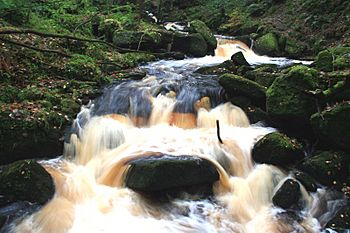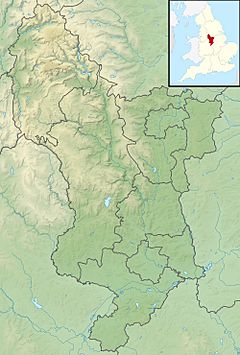Burbage Brook facts for kids
Quick facts for kids Burbage Brook |
|
|---|---|

Burbage Brook in Padley Gorge
|
|
|
Location of the mouth within Derbyshire
|
|
| Country | England |
| Region | Derbyshire |
| Physical characteristics | |
| Main source | Derbyshire, England |
| River mouth | Derbyshire, England 53°18′10″N 1°38′17″W / 53.302806°N 1.6380°W |
The Burbage Brook is a small stream in the Peak District of England. It is one of the streams that flows into the larger River Derwent.
Contents
What's in a Name?
The name Burbage Brook likely comes from an old Germanic word, baki, which means "creek" or "stream."
Where the Brook Flows
Starting Point: White Path Moss
The Burbage Brook begins its journey on the open moorland of Derbyshire. It starts north of its valley, collecting water from the land south of Friar's Ridge on a place called White Path Moss. This is close to Stanage Edge, a famous rocky ridge.
Through Burbage Valley
In its first kilometre, the brook drops quite a bit in height, over 60 metres! It goes from 396 metres to 335 metres above sea level. The water then enters the Burbage Valley and flows into Sheffield at the Upper Burbage Bridge.
The brook then winds through the Burbage Valley. This area once had a conifer tree plantation. These trees, like Lodgepole pine and Japanese larch, were planted by Sheffield City Council between 1968 and 1971. The outline of the plantation was even designed to look like Great Britain when seen from above! People sometimes called it the Great Britain Plantation. The part representing the West Country was not planted because of leftover items from World War II military training. The area around the brook was used for training by British and Canadian soldiers during the war.
Before the trees were planted, there was a plan to build a reservoir (a large artificial lake) here. However, this idea was stopped because the ground underneath was not suitable.
The plantation trees were cut down starting in 2014. This happened because of advice from the Moors for the Future Report and the South Yorkshire Fire and Rescue service. They wanted to reduce fire risks and help the natural moorland grow back.
Parts of the Burbage Valley are a Site of Special Scientific Interest (SSSI). This means it's a special protected area for nature. It's home to animals like the water vole. To protect these animals and their habitat, the cut tree trunks were removed by helicopter. This helped to reduce the impact on the environment. The tree stumps were left in the ground because experts thought there might be important archaeological remains (old historical items) hidden beneath.
New seeds from native trees, like Sessile Oak, have been planted in some areas where the plantation used to be. These seeds were collected from nearby woodlands. This project is expected to create more native woodland and open moorland around the brook.
The valley is surrounded by impressive natural features. Higger Tor and Carl Wark are to the west, and Burbage Rocks are to the east. Burbage Rocks is famous as one of the starting places for modern British climbing. As the brook leaves the old plantation area, it flows under a Grade II listed packhorse bridge. A packhorse bridge is an old, narrow bridge built for horses carrying goods. A "Grade II listed" building means it's an important historical structure.
Lawrence Field and Padley Gorge
The brook continues its journey down the valley. It flows under the A6187 at the lower Burbage Bridge. Near here, you can find a rock feature called Toad's Mouth and an ancient field system. The brook then re-enters Derbyshire at Lawrence Field.
Next, it flows into Padley Gorge, still within the Longshaw Estate. The woodland around the brook here, called Yarncliff Wood, is also a Site of Special Scientific Interest (SSSI). It's an important breeding spot for birds like the pied flycatcher, wood warbler, and hawfinch.
Finally, at Upper Padley, the Burbage Brook flows close to Grindleford railway station and Padley Chapel before joining the River Derwent.
Art Inspired by the Brook
The beautiful scenery of Burbage Brook has inspired artists. The artist Stanley Royle painted the brook from Upper Burbage Bridge in 1919. He also painted it from the lower Burbage Bridge at another time.


